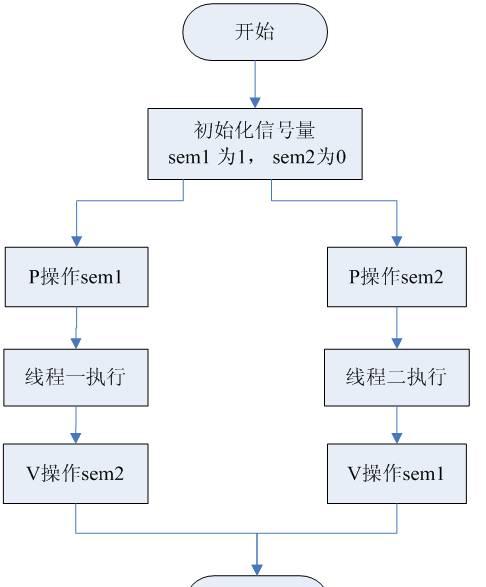
linux之线程同步一头歌答案
时间:2023-05-29 来源:网络 人气:
2023年05月29日,Linux操作系统在计算机领域的影响力依旧不可忽视。在多线程编程中,线程同步是一个非常重要的概念。本文将为您详细介绍Linux中的线程同步技术,包括互斥锁、条件变量、信号量等,帮助您更好地理解和掌握多线程编程。
一、互斥锁
互斥锁是Linux中最常用的线程同步技术之一。它可以确保在任何时候只有一个线程能够访问共享资源。当一个线程在访问共享资源时,它会尝试去获取互斥锁,如果该锁已经被其他线程占用,则当前线程会进入阻塞状态。只有当其他线程释放了该锁,当前线程才能够继续执行。
下面是一个使用互斥锁的示例代码:
c
#include<pthread.h>
#include<stdio.h>
pthread_mutex_tmutex;
void*thread_func(void*arg)
{
pthread_mutex_lock(&mutex);
printf("Thread%disaccessingthesharedresource.\n",*(int*)arg);
pthread_mutex_unlock(&mutex);
}
intmain()
{
pthread_tthread1,thread2;
intid1=1,id2=2;
pthread_mutex_init(&mutex,NULL);
pthread_create(&thread1,NULL,thread_func,&id1);
pthread_create(&thread2,NULL,thread_func,&id2);
pthread_join(thread1,NULL);
pthread_join(thread2,NULL);
pthread_mutex_destroy(&mutex);
return0;
}
上述代码中,我们使用了pthread_mutex_t类型的变量mutex来表示互斥锁。在主线程中,我们创建了两个子线程,并分别传递了它们的ID作为参数。在子线程中,我们首先调用pthread_mutex_lock函数来获取互斥锁,然后输出一条访问共享资源的信息,最后再调用pthread_mutex_unlock函数来释放互斥锁。
二、条件变量
条件变量是另一种常用的线程同步技术。它可以使得一个线程等待某个条件成立后再继续执行。当某个线程发现条件不满足时,它会调用pthread_cond_wait函数来等待条件成立。当其他线程改变了该条件时,它会调用pthread_cond_signal或pthread_cond_broadcast函数来唤醒正在等待的线程。
下面是一个使用条件变量的示例代码:
c
#include<pthread.h>
#include<stdio.h>
pthread_mutex_tmutex;
pthread_cond_tcond;
void*thread_func(void*arg)
{
pthread_mutex_lock(&mutex);
printf("Thread%diswaitingforthecondition.\n",*(int*)arg);
pthread_cond_wait(&cond,&mutex);
printf("Thread%dhasbeenwokenup.\n",*(int*)arg);
pthread_mutex_unlock(&mutex);
}
intmain()
{
pthread_tthread1,thread2;
intid1=1,id2=2;
pthread_mutex_init(&mutex,NULL);
pthread_cond_init(&cond,NULL);
pthread_create(&thread1,NULL,thread_func,&id1);
pthread_create(&thread2,NULL,thread_func,&id2);
sleep(3);//等待3秒钟,让子线程都进入阻塞状态
printf("Signalthecondition.\n");
pthread_cond_signal(&cond);
pthread_join(thread1,NULL);
pthread_join(thread2,NULL);
pthread_mutex_destroy(&mutex);
pthread_cond_destroy(&cond);
return0;
}
上述代码中,我们使用了pthread_cond_t类型的变量cond来表示条件变量。在主线程中,我们创建了两个子线程,并分别传递了它们的ID作为参数。在子线程中,我们首先调用pthread_cond_wait函数来等待条件成立,然后输出一条被唤醒的信息,最后再调用pthread_mutex_unlock函数来释放互斥锁。在主线程中,我们等待3秒钟后调用pthread_cond_signal函数来唤醒一个正在等待的线程。
三、信号量
信号量是一种比较底层的线程同步技术。它可以通过对一个计数器进行操作来实现线程之间的同步。当一个线程需要访问共享资源时,它会尝试去获取信号量,如果当前信号量的值大于0,则该线程可以继续执行,并将信号量的值减1。当一个线程使用完共享资源后,它会将信号量的值加1。
下面是一个使用信号量的示例代码:
c
#include<pthread.h>
#include<semaphore.h>
#include<stdio.h>
sem_tsem;
void*thread_func(void*arg)
{
sem_wait(&sem);
printf("Thread%disaccessingthesharedresource.\n",*(int*)arg);
sem_post(&sem);
}
intmain()
{
pthread_tthread1,thread2;
intid1=1,id2=2;
sem_init(&sem,0,1);
pthread_create(&thread1,NULL,thread_func,&id1);
pthread_create(&thread2,NULL,thread_func,&id2);
pthread_join(thread1,NULL);
pthread_join(thread2,NULL);
sem_destroy(&sem);
return0;
}
上述代码中,我们使用了sem_t类型的变量sem来表示信号量。在主线程中,我们创建了两个子线程,并分别传递了它们的ID作为参数。在子线程中,我们首先调用sem_wait函数来获取信号量,然后输出一条访问共享资源的信息,最后再调用sem_post函数来释放信号量。
四、总结
本文详细介绍了Linux中的线程同步技术,包括互斥锁、条件变量、信号量等。在多线程编程中,线程同步是一个非常重要的概念,它可以确保多个线程之间的正确协作,避免出现数据竞争等问题。希望本文能够帮助您更好地理解和掌握多线程编程。

imtoken钱包:https://cjge-manuscriptcentral.com/software/7022.html
教程资讯
教程资讯排行

系统教程
-
标签arclist报错:指定属性 typeid 的栏目ID不存在。












